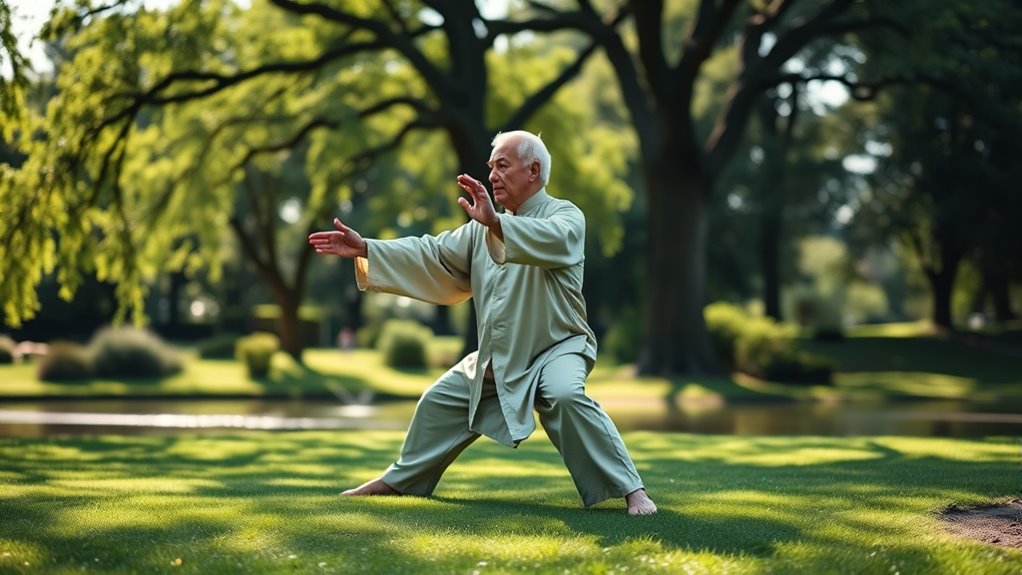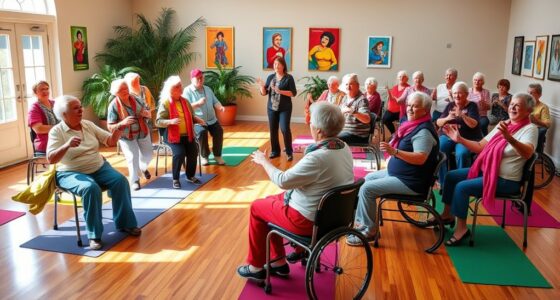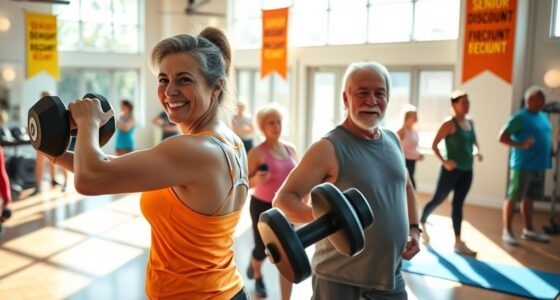Practicing Tai Chi can greatly improve your balance and flexibility by promoting proper posture, slow controlled movements, and mindful breathing. It encourages upright, relaxed alignment, strengthening your muscles and enhancing proprioception. Moving deliberately with attention to detail allows you to develop coordination and stability. Practicing barefoot increases sensory feedback and foot strength, while proper support and environment create a safe space. Keep exploring techniques and tips to deepen your understanding and experience lasting benefits.
Key Takeaways
- Tai Chi promotes balance by emphasizing centered posture, proper alignment, and controlled, deliberate movements.
- Regular practice enhances flexibility through gentle stretching and fluid motions that improve joint range of motion.
- Mindful breathing and relaxation techniques support stability and reduce tension, contributing to better balance.
- Practicing barefoot or in supportive footwear improves sensory feedback and foot muscle strength, boosting overall stability.
- Consistent Tai Chi routines foster long-term improvements in coordination, flexibility, and overall physical well-being.
Understanding the Benefits of Tai Chi for Overall Wellness
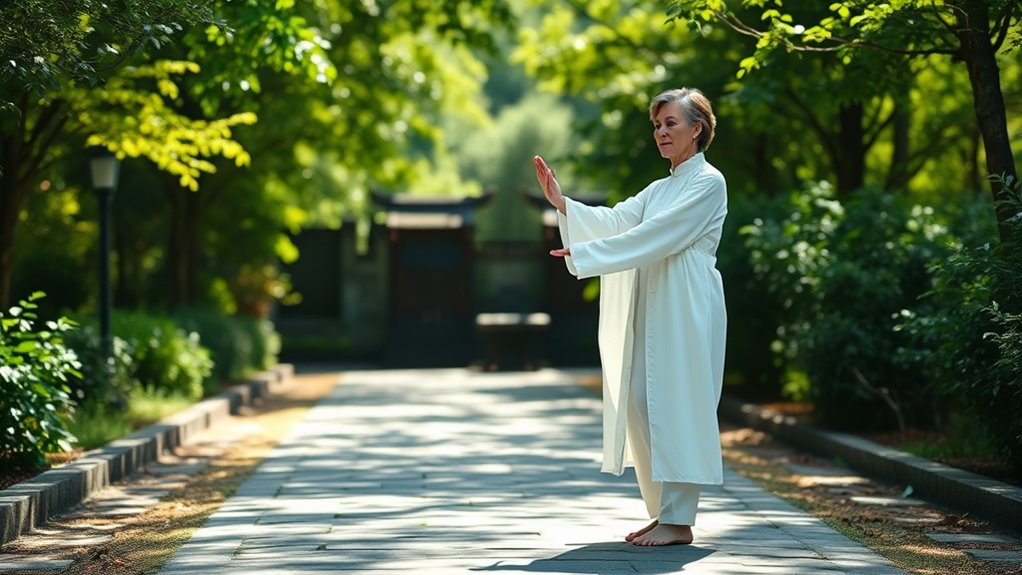
Understanding the benefits of Tai Chi for overall wellness reveals how this gentle practice can enhance your physical and mental health.
Discover how Tai Chi gently boosts your physical and mental well-being for a healthier, more balanced life.
As you practice, you’ll notice improvements in balance and stability, thanks to better proprioception and stronger lower limb muscles. Tai Chi’s slow, deliberate movements help increase flexibility by gently stretching joints and muscles, making daily activities easier. Engaging in mindful movement also supports joint health and mobility, which is particularly beneficial if you have arthritis or mobility limitations. Incorporating muscle strengthening exercises through Tai Chi can further improve overall stability and reduce injury risk. Regular practice can also reduce your risk of falls, especially as you age, by improving coordination and gait. Beyond physical benefits, Tai Chi promotes mental clarity and reduces stress through mindful movement. Additionally, the practice encourages mind-body connection, fostering greater awareness of your body and reducing mental fatigue. Maintaining physical balance is essential for healthy aging and overall well-being, and Tai Chi provides an effective way to support this. It’s also supportive for joint health and mobility, which is particularly beneficial if you have arthritis or mobility limitations. Additionally, research shows that mindful movement practices like Tai Chi can positively impact stress reduction, contributing to overall wellness.
Preparing Your Space and Setting Up for Practice
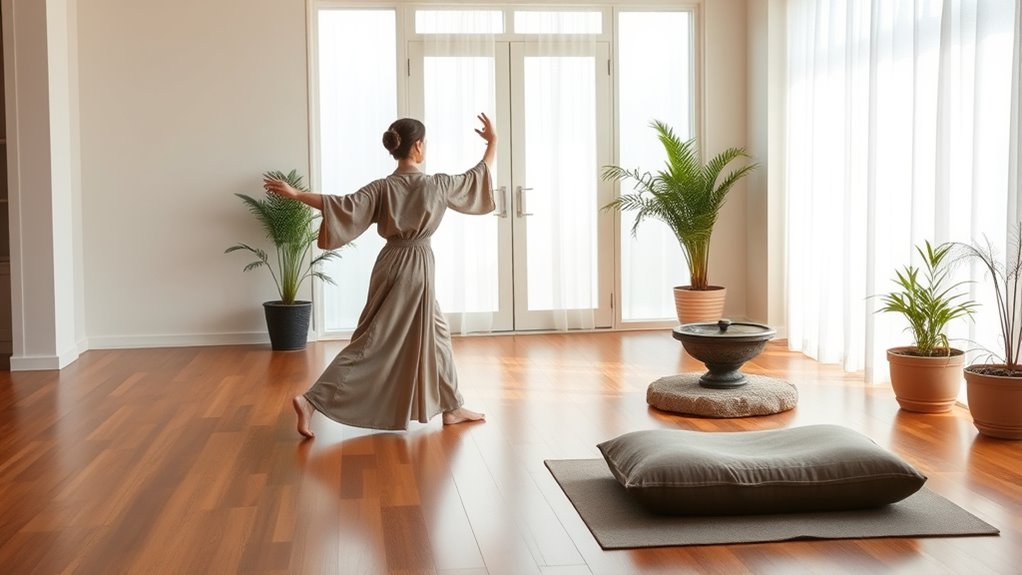
Setting up your practice space thoughtfully can make a significant difference in how comfortably and safely you perform your Tai Chi exercises. Clear the area of loose rugs, obstacles, and clutter to prevent tripping. Choose a quiet, well-lit space with enough room for both seated and standing moves. Use a non-slip surface or practice barefoot for better stability. Ascertain the temperature is comfortable to promote relaxation and ease of movement. If needed, arrange supportive footwear or mats for additional foot or ankle support. Being aware of local resources can also help you find suitable spaces or classes in your area. Incorporating specialized plant pots can create a calming environment that enhances your practice space. Additionally, considering the environment’s cleanliness can help maintain a healthy practice area. Ensuring proper air quality can also contribute to better breathing and overall comfort during your practice.
Selecting the Right Attire and Footwear for Comfort and Support
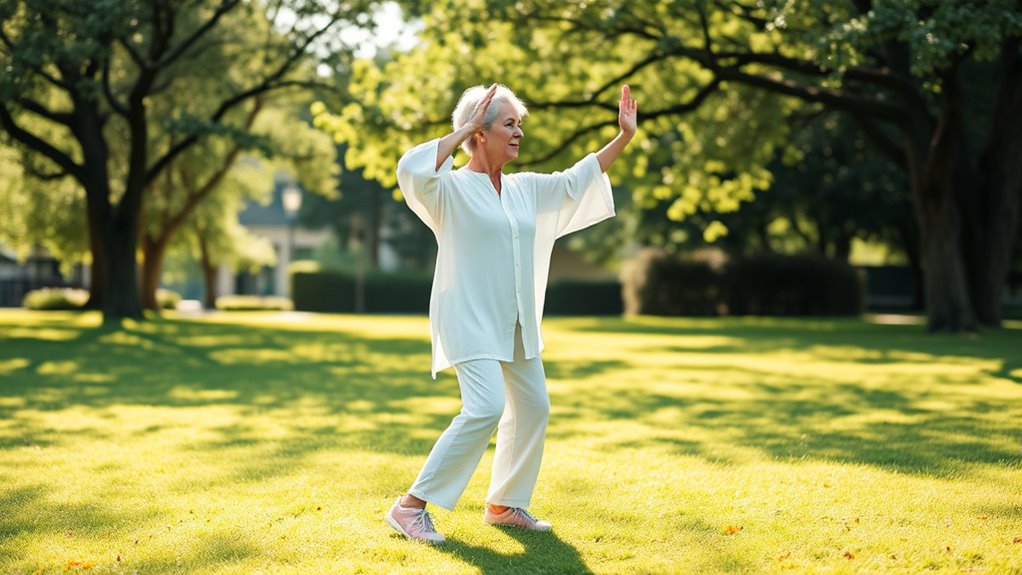
Choosing the right attire and footwear can make a big difference in your Tai Chi practice. Wear loose, comfortable clothing that moves with you. Select supportive, non-slip shoes with flat soles for stability. If you prefer practicing barefoot, guarantee your surface is safe and clean to improve balance and proprioception. Additionally, wearing footwear with proper grip and support can help prevent slips and injuries during movements. Ensuring your footwear provides adequate foot support can also reduce strain on your joints and enhance overall stability during practice. Properly fitting shoes with adequate cushioning can help absorb impact and make your practice more comfortable. Maintaining a clutter-free space by organizing your practice area can further improve your focus and safety during Tai Chi sessions.
Comfortable Clothing Choices
Wearing the right clothing and footwear can substantially enhance your Tai Chi practice by providing comfort and support. Choose loose, breathable clothing that allows full range of motion, like lightweight tops and flexible pants or yoga leggings. Avoid tight or restrictive outfits that could hinder your arm and leg movements or cause discomfort.
Opt for comfortable footwear with supportive soles, such as athletic shoes or slip-on styles, to improve stability during your practice. Here are some tips:
- Wear loose, breathable clothing for freedom of movement.
- Select supportive shoes to enhance stability.
- Avoid tight or restrictive attire that limits motion.
- Practice barefoot on a clean, non-slip surface for better balance.
Dressing appropriately keeps you comfortable and helps you move confidently through each Tai Chi session.
Supportive Footwear Options
Selecting the right footwear can considerably improve your Tai Chi practice by offering the necessary support and stability. Look for shoes with cushioned insoles and stable soles to enhance balance and reduce fatigue. Shoes with non-slip soles give you better grip on smooth or slippery surfaces, lowering the risk of falls. Choose athletic or walking shoes made of flexible, breathable materials that allow natural foot movement and keep your feet comfortable during practice. Opt for footwear with a low heel and firm arch support to help maintain proper alignment and stability through your movements. If you prefer barefoot practice, ensure the floor is clean, smooth, and free of hazards to prevent injuries and promote safe stretching. The right footwear balances support, comfort, and safety for effective Tai Chi practice. Incorporating performance cookies into your routine can also help monitor your progress and improve your technique over time. Additionally, ensuring your headphones are properly paired and functioning can enhance your practice sessions if you use audio guidance or music to stay motivated. Using appropriate footwear can also minimize the risk of injuries caused by inadequate support or slippery surfaces. Research indicates that choosing the proper footwear can also aid in home safety by reducing the chance of slips and falls during practice.
Barefoot Practice Benefits
Have you ever considered how practicing Tai Chi barefoot can boost your balance and stability? Going barefoot enhances sensory feedback from the floor, sharpening your proprioception and helping you stay grounded. It also improves grip and stability, reducing slips during movements.
Moving without shoes encourages natural foot alignment and strengthens your foot muscles over time. If you prefer, supportive footwear with flexible soles offers extra comfort without compromising movement mechanics.
To maximize safety and comfort, consider these options:
- Practice barefoot on a clean, non-slip surface.
- Use lightweight, breathable socks for added comfort.
- Choose minimalist shoes if barefoot isn’t possible.
- Focus on maintaining proper foot alignment during practice.
- Incorporate proper footwear choices to support your practice and prevent injuries.
- Additionally, selecting appropriate footwear can help maintain proper biomechanics and enhance your overall practice experience.
- Paying attention to footwear materials ensures comfort and flexibility during your movements.
- Staying updated on advancements in footwear technology can further improve your Tai Chi practice.
These tips help you enjoy the full benefits of barefoot Tai Chi for better balance and flexibility.
Basic Principles of Movement and Posture in Tai Chi-Inspired Practice
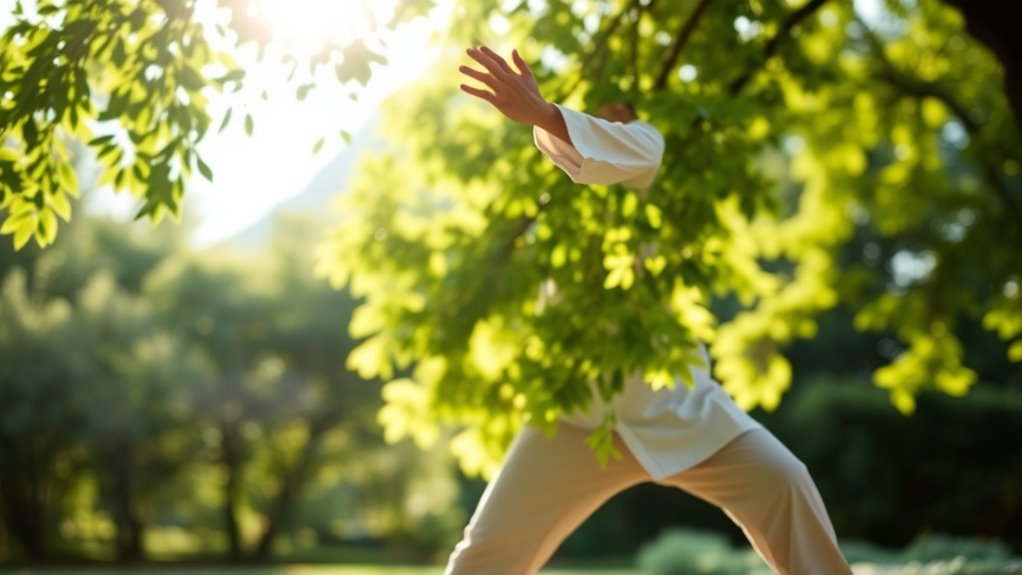
To improve your Tai Chi practice, focus on maintaining a centered posture that aligns your spine and distributes your weight evenly.
Move smoothly and intentionally, coordinating your movements with your breath to create a flowing rhythm.
Pay attention to your hand and arm positions, keeping them aligned with your body’s centerline for better balance and energy flow.
Centered Posture Alignment
Maintaining a centered posture in Tai Chi is essential for achieving balance and fluidity in movement. When you keep your spine upright and relaxed, with your head aligned over your shoulders, you create a stable foundation. Proper alignment involves gently engaging your core muscles to support the natural curves of your spine, which enhances your posture. Distributing your weight evenly across your feet with a slight bend in your knees helps you stay grounded. Remember, all movements should originate from your center, with your torso acting as a pivot point for smooth, coordinated motion. Focusing on this posture improves your proprioception and keeps your practice safe and effective. Additionally, understanding the principles of posture alignment can significantly enhance your practice and prevent injury. For example, maintaining correct breast cancer screening guidelines ensures early detection and better outcomes. Developing a mindful awareness of movement principles can further refine your technique and promote harmony between your body and mind. 1. Keep your spine upright and relaxed 2. Support your natural spine curves with gentle core engagement 3. Distribute weight evenly across your feet 4. Initiate movements from your body’s center
Coordinated Movement Flow
Achieving smooth, coordinated movement in Tai Chi-inspired practice relies on the deliberate synchronization of your arms, legs, and torso. Focus on slow, controlled progressions that promote fluidity and harmony between your body parts.
Maintaining an upright, relaxed posture with centered weight distribution enhances stability and makes movements more effortless. Practice synchronizing arm and leg actions, like pressing down with one hand while lifting with the other, to develop better motor control and body awareness.
Use heel-toe foot placement and mindful sequencing of steps to support your balance and reinforce proper alignment. Incorporate deep, rhythmic breathing, matching your breath to your movements, to further enhance coordination and relaxation.
This mindful flow creates a seamless connection between your mind and body.
Mindful Breathing Technique
Practicing mindful breathing in Tai Chi-inspired movement enhances your focus and relaxation by coordinating your breath with gentle, deliberate motions. To do this effectively, focus on deep, slow breaths through your nose, keeping your posture upright with a relaxed, elongated spine and relaxed shoulders.
Synchronize your breath with your arm and leg movements to improve coordination and balance, strengthening the mind-body connection. Visualizing expanding a ball or balloon during inhalation and contracting it during exhalation deepens your breath awareness and calms your mind.
Consistent practice reinforces proper technique, reduces stress, and supports overall well-being. To guide your practice:
- Breathe deeply and slowly through your nose.
- Maintain good posture with an elongated spine.
- Coordinate your breath with movement.
- Visualize expanding and contracting during inhalation and exhalation.
Breathing Techniques to Enhance Relaxation and Focus
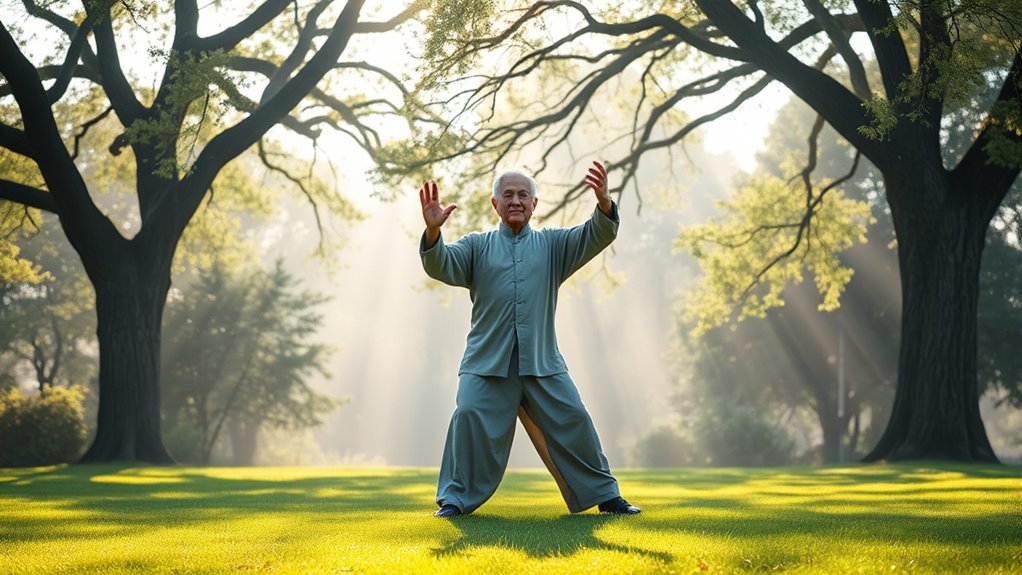
Integrating deep, diaphragmatic breathing into your Tai Chi practice activates the parasympathetic nervous system, which helps you relax and reduces stress. When you coordinate your breath with movement—inhale while expanding your arms, exhale as you contract—you sharpen your focus and cultivate mindfulness.
Practicing slow, steady breaths increases oxygen flow to your muscles and brain, boosting concentration and stability. By intentionally cycling your breath during routines, you can lower cortisol levels, supporting emotional balance and mental clarity.
Using breath awareness as a foundation deepens your mind-body connection, which is essential for improving balance and flexibility through Tai Chi. This mindful breathing not only calms your nerves but also enhances your overall practice, making your movements more fluid and controlled.
Gentle Warm-Up Movements to Prepare the Body
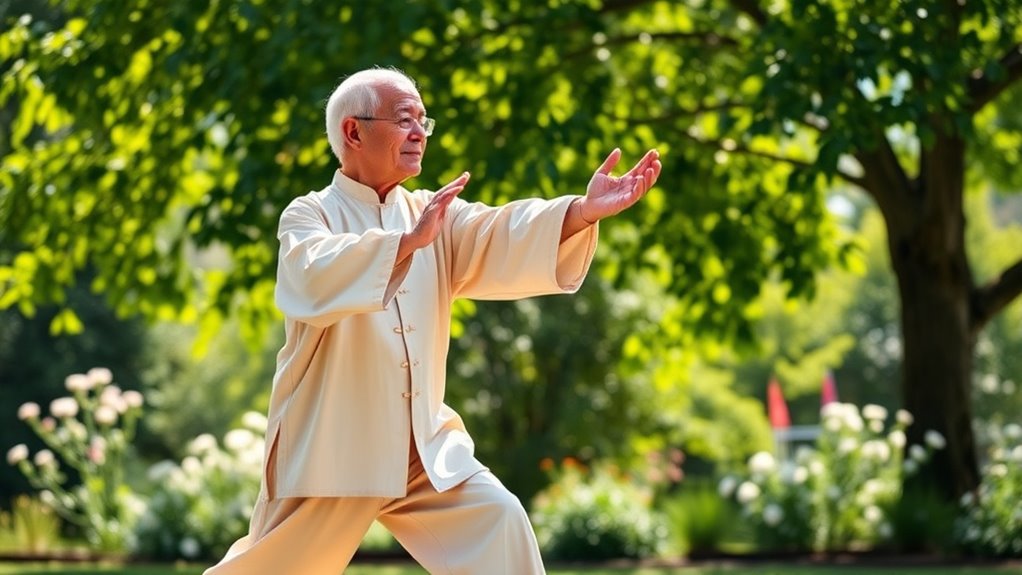
Starting your Tai Chi practice with gentle warm-up movements helps prepare your body by gradually increasing blood flow and improving muscle elasticity. These slow, deliberate stretches target key muscle groups like your shoulders, back, and legs, reducing injury risk. Incorporating deep breathing enhances relaxation and sets a focused mindset.
Begin with seated or standing gentle stretches to boost flexibility and joint mobility before moving into more complex exercises. Consistent warm-up routines also improve balance and coordination, making your practice safer and more effective.
To get started, try these simple steps:
- Gentle shoulder rolls to loosen neck and shoulder muscles
- Slow torso twists to activate your core and back
- Leg swings or calf raises to warm up your lower limbs
- Deep breathing combined with gentle neck stretches
Key Tai Chi-Inspired Exercises for Balance and Flexibility
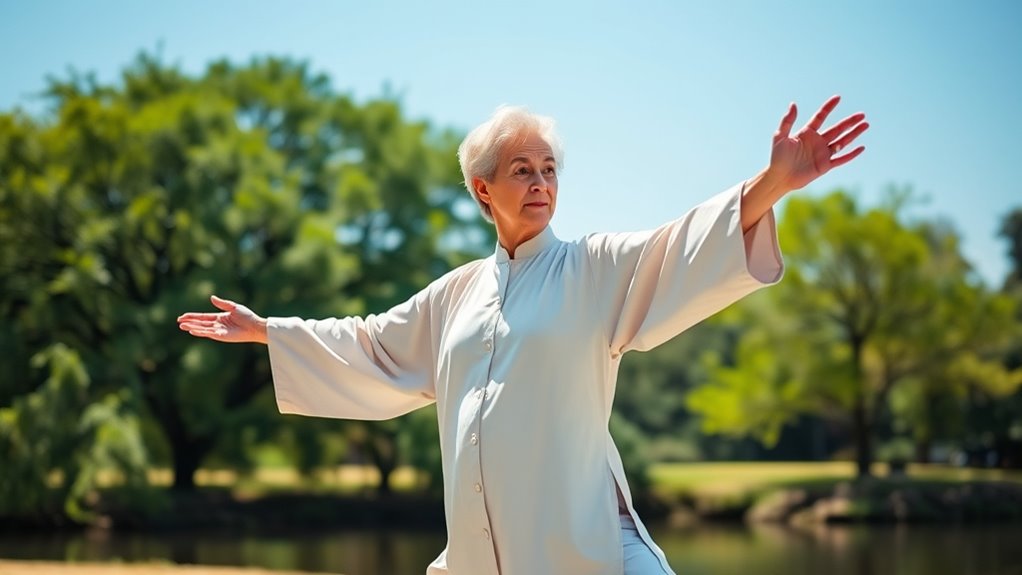
Incorporating key Tai Chi-inspired exercises into your routine can considerably enhance your balance and flexibility. Slow heel-toe walking improves proprioception and stability by challenging your coordination on uneven surfaces.
Spinal stretches with arm presses increase joint flexibility in your hips, shoulders, and spine, supporting better movement. Coordinated punching motions help build muscle coordination and stability, which are essential for maintaining balance during daily activities.
These exercises utilize flowing, deliberate movements that strengthen muscles and promote better posture. Combining gentle stretching with controlled postures boosts joint mobility, especially in key areas like the hips and shoulders.
Focused breathing during these exercises fosters relaxation and enhances mind-body awareness, making your practice more effective for improving overall flexibility and equilibrium. Regular practice offers significant benefits for your mobility and fall prevention.
Incorporating Coordination and Mindfulness in Daily Practice
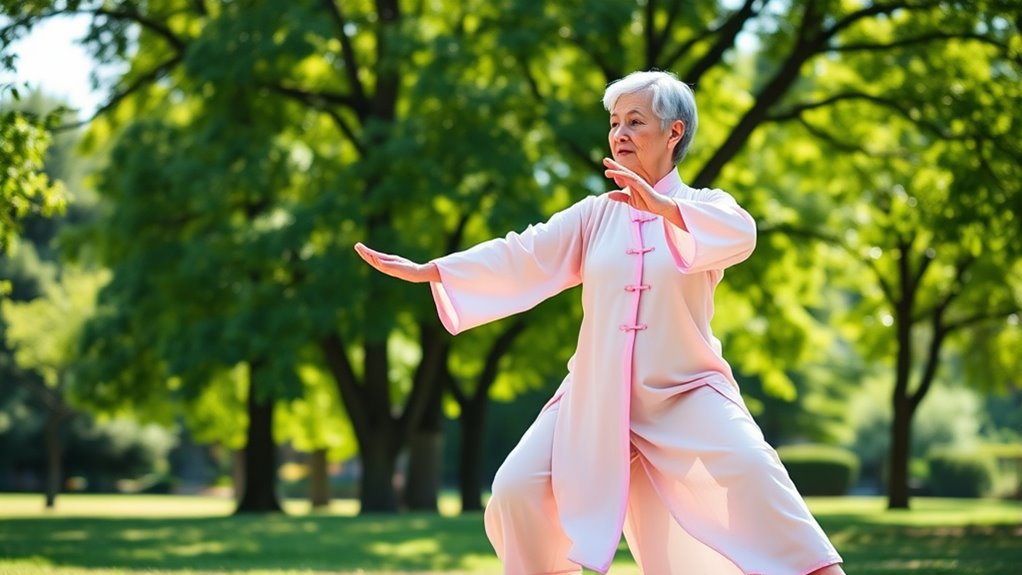
Building on the benefits of flow and flexibility from Tai Chi-inspired exercises, adding coordination and mindfulness into your daily practice can deepen your connection to movement. To do this effectively, focus on integrating deliberate actions and present-moment awareness.
Consider these steps:
- Synchronize your arm and leg movements, like heel-toe stepping paired with fluid punches, to improve motor control.
- Use visualizations, such as imagining holding a beach ball during stretches, to strengthen mind-body awareness.
- Practice slow, controlled repetitions of movement patterns to reinforce neural pathways and foster relaxation.
- Incorporate mindful breathing, syncing each inhale and exhale with your movements, to promote calmness and centeredness.
This approach enhances both coordination and mindfulness, enriching your daily Tai Chi routine.
Cooling Down and Relaxation Strategies to Complete Your Routine
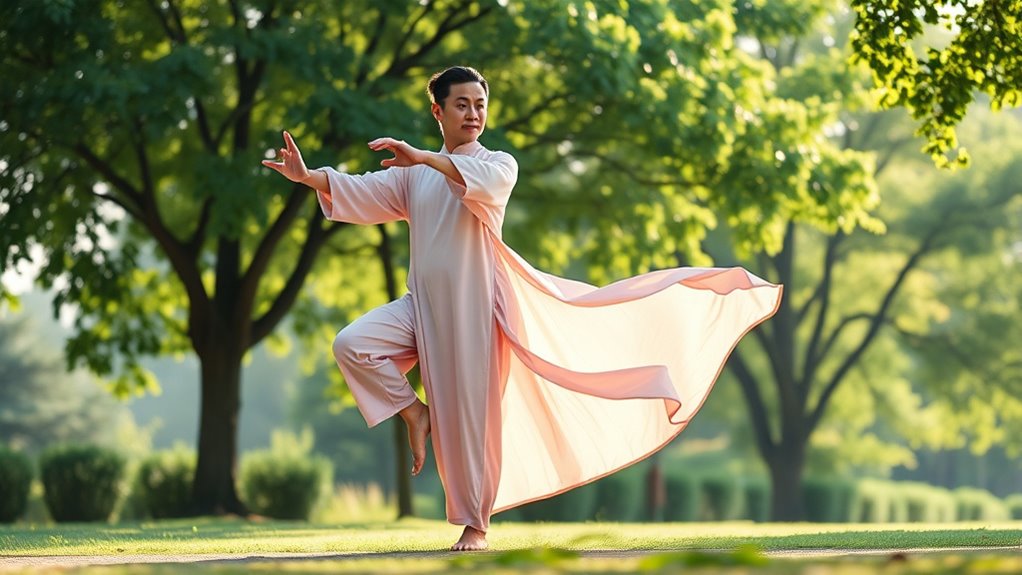
Cooling down after your Tai Chi session helps your body shift from movement to rest by gently relaxing muscles and calming the mind. You can do this by incorporating slow, deep breathing cycles to gradually lower your heart rate and release tension.
Using seated or lying down positions can support relaxation and help muscles and joints let go of built-up stress. Focused breathing exercises enhance mindfulness, clear your mind, and prepare you for rest.
Consistently applying these relaxation strategies not only helps you feel more centered but also improves your overall flexibility and balance over time. Taking a few moments to wind down ensures your body transitions smoothly from activity to relaxation, maximizing the physical and mental benefits of your Tai Chi practice.
Tips for Maintaining Consistency and Progress in Your Practice
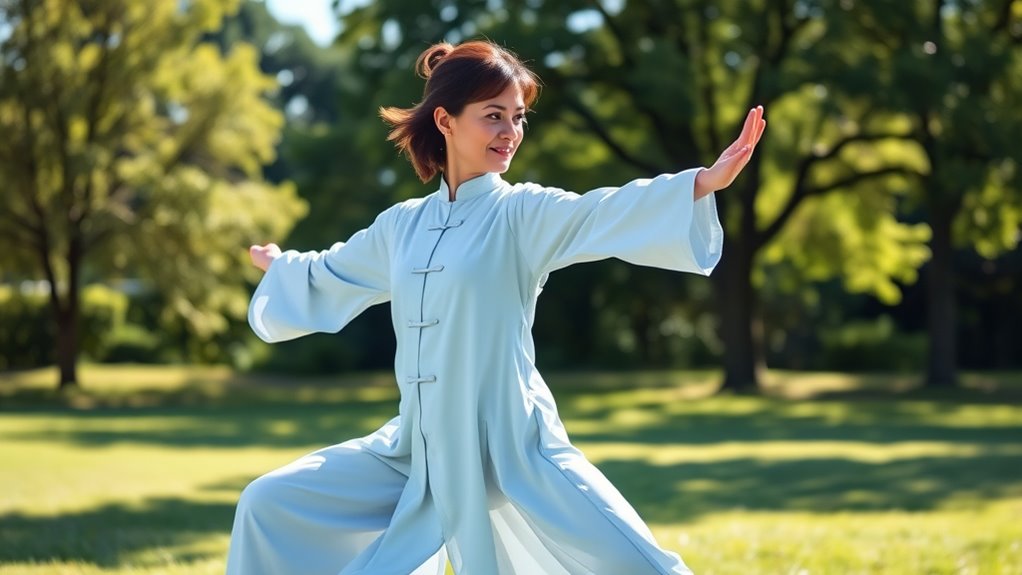
Maintaining consistency in your Tai Chi practice is the best way to see steady progress and enjoy its full benefits. Regular practice helps build muscle memory and improves balance.
Consistency in Tai Chi practice fosters steady progress and maximizes its benefits.
To stay motivated and on track, consider these tips:
- Set small, achievable goals to monitor your progress and keep motivation high.
- Incorporate variety by mixing seated and standing exercises to prevent boredom and boost overall flexibility.
- Use a routine checklist or journal to reinforce regular practice and identify areas needing more focus.
- Listen to your body and gradually increase the intensity of movements to avoid injury and ensure sustainable growth.
Sticking to these strategies will help you develop a consistent routine that promotes steady improvement in your balance and flexibility.
Frequently Asked Questions
Can Tai Chi Improve Balance?
Yes, practicing Tai Chi can improve your balance. You actively engage in slow, deliberate movements that boost your proprioception and strengthen your leg muscles. These exercises help you become more aware of your body’s position, making you more stable.
Over time, you’ll notice improvements in your posture and gait, which can reduce your risk of falls. Plus, you’ll feel more confident and less afraid of losing your balance.
Can Tai Chi Improve Flexibility?
You might wonder if Tai Chi can improve flexibility, and evidence suggests it does. By practicing slow, flowing movements, you gently stretch muscles and joints, increasing your range of motion over time.
This mindful exercise helps loosen stiff muscles, especially in the hips, shoulders, and spine. Regular practice not only enhances flexibility but also promotes relaxation, reduces stiffness, and can lower fall risk, particularly for older adults.
Is Tai Chi or Yoga Better for Balance?
You’re wondering whether Tai Chi or yoga is better for balance. Tai Chi excels because its slow, deliberate movements and weight shifts directly improve your postural stability and coordination.
Yoga can help with balance too, especially through poses that target stability, but it’s often more static.
For the best results, consider combining both practices, as they offer complementary benefits for your overall balance and flexibility.
How Can I Improve My Balance and Flexibility?
Ever wonder how to stand taller and move freer? You can improve your balance and flexibility by practicing slow, controlled movements that strengthen muscles and increase joint range.
Focus on weight-shifting, heel-toe walking, and gentle stretches to boost stability and mobility. Incorporate mindful breathing to enhance relaxation and concentration.
With consistency, these exercises become your secret weapon against imbalance and stiffness, transforming your body into a more agile, resilient version of itself.
Conclusion
So, after all this talk about slow moves and gentle stretches, you might think Tai Chi is just a relaxing pastime. But don’t be fooled—those mindful breaths and precise postures build strength and balance you never knew you needed. Ironically, in slowing down, you’re actually training your body to move faster and more confidently. So take it seriously—you’re quietly preparing yourself for life’s unpredictable twists, one peaceful step at a time.
